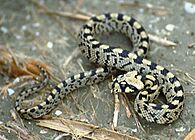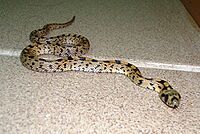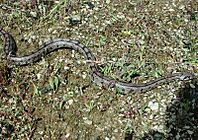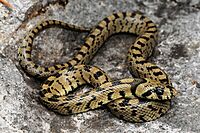Ladder snake facts for kids
The ladder snake (Zamenis scalaris) is a cool snake found in southwestern Europe. It's not venomous, meaning it's not dangerous to humans. This snake belongs to a group called Colubridae.
Quick facts for kids Ladder snake |
|
|---|---|
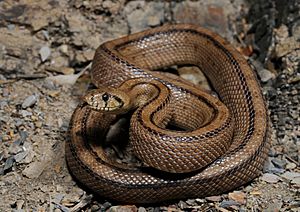 |
|
| Conservation status | |
| Scientific classification | |
| Genus: |
Zamenis
|
| Species: |
scalaris
|
 |
|
| Range map | |
| Synonyms | |
|
|
Contents
Where Ladder Snakes Live
The ladder snake lives in several countries in southwestern Europe. You can find them in Portugal, Spain, and southern France. They also live a little bit in Italy.
They are also found on islands like Menorca and the Iles d'Hyères. However, they are not found in northern Spain, including the Pyrenees mountains. The snakes on Menorca might have been brought there by people.
What Their Habitat Is Like
Ladder snakes love places with lots of bushes and plants. This includes fruit farms, vineyards, and old stone walls. They are common in areas with thick shrubs called maquis.
They prefer spots with rocks and boulders, and some shade. While they can live high up, they mostly like lower areas. They are usually found from sea level up to about 700 meters (2,300 feet) high.
What Ladder Snakes Look Like
The ladder snake is a medium-sized snake. It can grow up to about 160 centimeters (63 inches) long, but usually averages around 120 centimeters (47 inches). It has a pointed nose.
Adult ladder snakes are often yellowish to dark brown. They have two darker stripes running from their neck all the way to their tail. They also usually have a dark stripe from their eye to their jaw. Their belly is light, from silvery-grey to whitish, sometimes with dark spots. Their eyes are dark.
Young ladder snakes look different! They are brighter, from yellow to light brown. They have a special "ladder" pattern in black along their back. Their light belly has black marks that can sometimes cover the whole underside. As they get older, these colors and patterns fade, and they get the simpler adult look.
What Ladder Snakes Eat
Ladder snakes are sometimes called "rat snakes" because they mostly eat small animals. About 75% of their diet is mammals like mice, rabbits, and shrews.
They also eat spiders, insects (especially grasshoppers), and some birds. To catch birds, they will climb trees or buildings to find nests. They also eat lizards. Young ladder snakes prefer small lizards, baby rodents, spiders, and grasshoppers.
How Ladder Snakes Behave
Ladder snakes are usually active during the day. But on very hot summer days, they might come out at night. In spring, they might be more active around dawn and dusk.
They are known to be more aggressive than some other snakes. If they feel threatened, they might hiss and lunge forward with their mouth open. If you try to pick one up, it might bite you. They can also release a stinky smell from special glands to scare you away.
These snakes move around a lot. They can travel up to 100 meters (330 feet) in a day. An individual snake's home area is usually about 4,500 square meters (about an acre). Adult snakes might go into barns to find rodents, but they usually prefer to hide in rodent burrows, piles of stones, or hollow trees.
Ladder Snake Reproduction
In Spain and Portugal, ladder snakes usually mate in May and June. However, some females do not lay eggs every year. Mating can last for about an hour.
About 3 to 6 weeks after mating, the female lays a clutch of eggs. On average, she lays about 15 eggs, but it can be anywhere from 4 to 24 eggs. The eggs hatch after 5 to 12 weeks. Baby snakes are about 20 centimeters (8 inches) long when they hatch.
Interestingly, the mother snake might stay with her newly hatched babies for a few days. Both male and female ladder snakes become old enough to reproduce around 5 years of age. At this time, males are about 50 centimeters (20 inches) long, and females are about 65 centimeters (26 inches) long.
Conservation Status
The IUCN (International Union for Conservation of Nature) says the ladder snake is a "Least Concern" species. This means there are lots of them, and they are not currently in danger. They can live in many different types of places and are found over a large area.
Gallery
See also
 In Spanish: Culebra de escalera para niños
In Spanish: Culebra de escalera para niños



